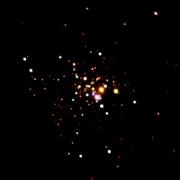Globular Clusters
Globular clusters, those dense clusters of ancient stars that are the oldest stellar systems in galaxies and our Milky Way, are rich targets for study with the Chandra X-ray Observatory. Their stellar densities are so high (a million times more stars per unit volume than in the solar neighborhood) that encounters between individual stars and between binaries (pre-existing) and single stars are frequent enough that binary populations including exotic objects (neutron stars and white dwarfs) are created ~100X more efficiently than in the Galaxy as a whole. Chandra has revealed the rich population of X-ray binary systems containing neutron stars in quiescent low mass X-ray binaries (qLMXBs) and white dwarfs in cataclysmic variables (CVs). Deep Chandra images of globulars have also discovered the much larger population of qLMXB descendents, the millisecond pulsars (MSPs), with neutron stars spinning some 500 times per second and detected by the X-ray emission from their hot polar caps. Some of these MSPs have acquired new binary partners to replace those that spun them up originally: Chandra (and correlative HST) observations have revealed the partner swapping in these crowded stellar swarms. And finally the active binaries -- normal cluster stars in close binary pairs which in some cases are surprisingly luminous X-ray sources showing highly active and flaring coronae never anticipated for such ancient stars. The remarkable high resolution X-ray (Chandra) and optical (HST) observations of globulars reveal reveal entirely new facets of compact objects, stellar binary systems and the very evolution of the clusters themselves.
Jonathan Grindlay, Peter Edmonds, Maureen van den Berg




